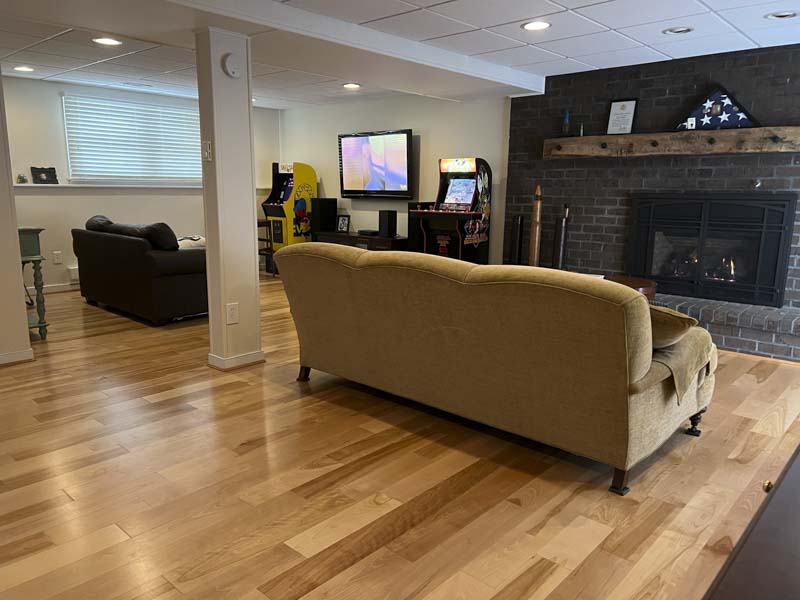Laminate flooring is a popular choice for many homeowners. It’s a cost-effective flooring option available in many styles and colors. To find out if it’s right for your home, learn more about the pros and cons of laminate flooring.
What Is Laminate Flooring?
Laminate flooring has been around since the 1970s, providing a cost-effective alternative to traditional flooring. It’s a synthetic product with various layers designed to look like real wood or stone flooring.
Laminate flooring comes in various colors and styles, some quite luxurious. It’s easy to install and you can lay it on top of existing floors, including concrete, wood, and vinyl flooring.
All laminate flooring is cheaper than wood or stone, with some products priced under $1 per square foot. However, it’s not the most durable flooring option. The life expectancy of laminate flooring is about half of products like hardwood flooring or ceramic tile.
The Pros and Cons of Laminate Flooring
There are several pros and cons of laminate flooring. First, take a look at the advantages of laminate flooring.
Durability and Longevity
Laminate flooring may not be as long-lasting as wood floors, but that doesn’t mean they aren’t durable. Depending on their quality and abrasion class (AC) rating, laminate floors can last 15 to 25 years without needing maintenance, sanding, or resealing.
As mentioned, laminate flooring comprises five or six layers sandwiched together. The top layer is the protective wear layer, and the thickness of the wear layer determines how durable it is. Typically, the price per square foot of laminate flooring increases with the thickness of the wear layer.
Affordability

Laminate is one of the most widely used cheap flooring options. It’s comparable in price to sheet vinyl and linoleum flooring, but it doesn’t puncture, scratch, or dent as easily.
Easy Maintenance
Unlike hardwood flooring, laminate flooring requires little to no special care. You never have to seal it or restain it. Regular sweeping and occasional damp mopping are enough to keep laminate floors in good condition.
Versatility
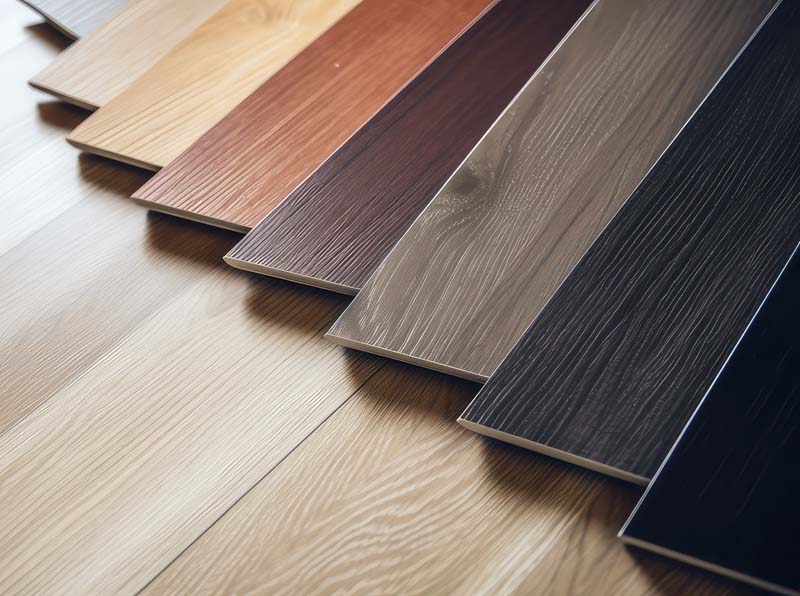
Versatility is an important factor when exploring the pros and cons of laminate flooring.
Laminate flooring comes in a wide range of styles, textures, patterns, and colors, allowing you to choose exactly the look you want for your home’s interior decorating. You can install laminate flooring on any subfloor and even lay it over many types of existing floors.
DIY-Friendly Installation
One of the main benefits of laminate flooring is its affordability, and the fact that it’s DIY-friendly makes it even more affordable than other flooring options. Most homeowners find the click-and-lock type of laminate flooring simple enough to install on their own.
The Disadvantages and Cons of Laminate Flooring
While there are plenty of pros about laminate flooring, there are also a few cons that you should consider. It’s best to understand the disadvantages of laminate flooring before you commit to this type of flooring.
Limited Authenticity
There are brands and styles of laminate flooring that do a better job of appearing authentic, but most laminate flooring lacks the genuine appeal of natural wood floors. Other products, like wood-look ceramic or porcelain tiles, do a better job of looking like real wood than laminate does.
That doesn’t mean that laminate flooring lacks appeal, however. What it does mean is that you aren’t going to fool anyone into thinking that your laminate floors are the real thing. They’ll still look good, but they don’t look real.
Susceptibility to Moisture
One significant drawback to laminate flooring is that it’s vulnerable to moisture. The core layers are made from wood fibers, and although there have been improvements made since laminate flooring first came on the market, much of it is easily damaged by excessive moisture.
Some brands offer a water-resistant laminate flooring plank, but it still doesn’t hold up as well as products like waterproof vinyl flooring planks. Luxury vinyl plank (LVP) flooring is the clear choice for bathrooms and kitchens, but it’s more expensive, usually starting at about $5 per square foot.
Environmental Concerns
To be considered eco-friendly, a product has to meet green requirements throughout its lifecycle, from manufacturing to disposal. In the past, laminate flooring has missed the mark when it came to green manufacturing.
Fortunately, the evolution of laminate flooring is marked by a growing emphasis on sustainability. According to the North American Laminate Flooring Association, laminate flooring provides numerous environmental benefits. Manufacturers use few raw materials in laminate flooring, and it’s a highly recyclable product. It’s also easy to find many formaldehyde-free products.
Noise and Comfort
Laminate flooring is a hard surface, and it lacks the comfort of floor coverings like vinyl or carpet. Laminate flooring also produces a hollow sound when it’s walked on.
Some brands offer padded planks that enhance the comfort level of laminate flooring when it’s walked on, but the best way to make it feel more comfortable is to choose a quality underlayment with sound-dampening properties.
Tips for Installing Laminate Flooring
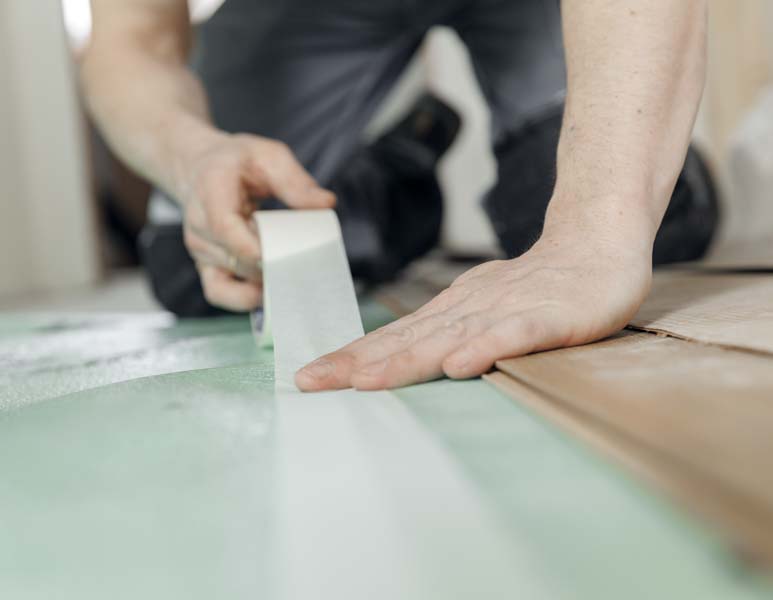
Many DIYers tackle laminate flooring installations with fantastic success. Proper preparation and attention to detail is critical, but it’s not hard to do. Follow these tips for a successful laminate flooring installation.
Proper Preparation
Like most projects, proper preparation takes time but is the best way to ensure good results. Here are some recommendations to properly prepare for a laminate flooring installation:
- Start with a smooth, clean subfloor. Inspect the floor with a straightedge, and use a belt sander to knock down high spots.
- Walk around and screw the plywood to the joists wherever you find spongy areas or squeaks.
- Plan the layout, taking the natural light and pathways into account when considering the direction of the planks.
- Measure the walls and determine if they are parallel. If not, be sure to taper both sides evenly so it splits the difference and is less noticeable.
- Be sure to sweep and vacuum before installing the underlayment.
Choosing the Right Underlayment
Underlayment is critical for a long-lasting, quality laminate flooring installation. Here’s what to look for when choosing the right underlayment:
- Thickness–Underlayment is usually ⅛ to ½ inch. The thicker your underlayment, the softer your floor will feel.
- Compression resistance–High-quality underlayment takes longer to compress. Thick underlayments don’t necessarily have high compression resistance.
- Sound absorption–You may want to choose underlayment that’s designed specifically as a noise barrier. In multi-story buildings, sound is a more critical factor.
- Moisture wicking–If you live in a humid environment or you’re installing laminate flooring in your kitchen, this will be more important.
Acclimation Period
Before installing laminate flooring, allow the boxed planks to acclimate for about 48 hours in the room where they’ll be installed.
Laminate flooring expands with humidity and heat, and contracts with cold, dry air. When you give it time to acclimate, you’re less likely to have problems related to shrinking and expanding planks.
DIY vs. Professional Laminate Flooring Installation: Pros and Cons
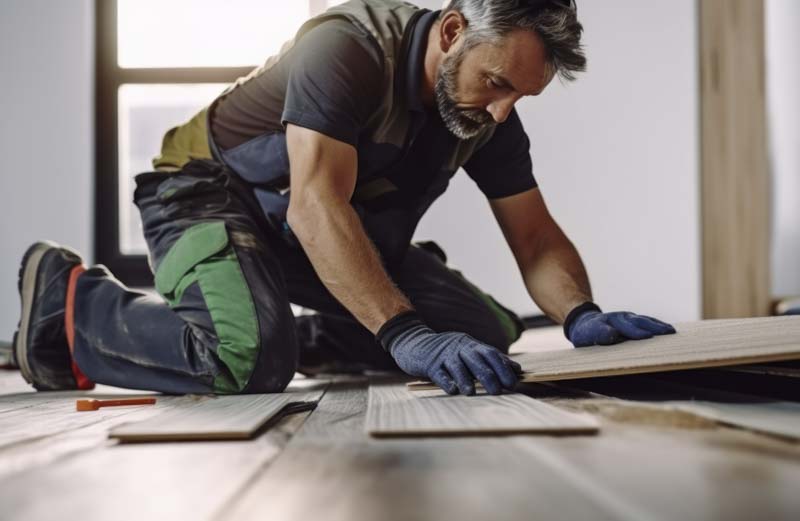
To determine if DIY or professional installation is right for you, consider factors like your skill level and how much available time you have.
With a DIY installation, you can enjoy the cost savings and sense of accomplishment you get from a job well done. However, if you lack the necessary skills, it can lead to mistakes and uneven installations.
Professional laminate floor installers have the expertise to quickly and efficiently install your floor. They are less likely to make errors during installation, resulting in a polished final result.
Who Should Consider the Pros and Cons of Laminate Flooring?
Laminate flooring isn’t for everyone, but it’s the perfect choice for homeowners on a budget, people with pets, and rental properties.
Homeowners on a Budget
Compared to traditional flooring options, laminate flooring is cost-effective. If you’re remodeling a small room in your home on a tight budget, you can install laminate flooring for around $1 per square foot, making it extremely affordable compared to high-end wood floors that cost $15 to $20 per square foot.
Pet Owners

From scratches to messy accidents, pets take a toll on your home’s floors. Laminate flooring’s durability and affordability make it a top choice for pet owners. It’s scratch-resistant and easy to clean, and since it costs much less, it won’t hurt your wallet as much if you have to replace it.
Rental Properties
If you have a rental property, you already know how hard renters can be on floors. It’s easy to enhance the look of your rental with a fresh new laminate floor without making a significant investment.
Additional Considerations for Laminate Flooring
Before installing laminate flooring, here are some additional factors to consider.
Future Resale Value
If you’re planning on selling your home, any type of new flooring will help improve the look and feel of your home’s interior. However, there’s a considerable difference between the return on your investment when you install laminate versus hardwood floors.
With hardwood, many homeowners see up to a 150% ROI, while laminate flooring is closer to 80%. It’s important to consider other factors, however, and choose the right flooring that fits best with your home’s overall aesthetic.
Style and Aesthetic Preferences
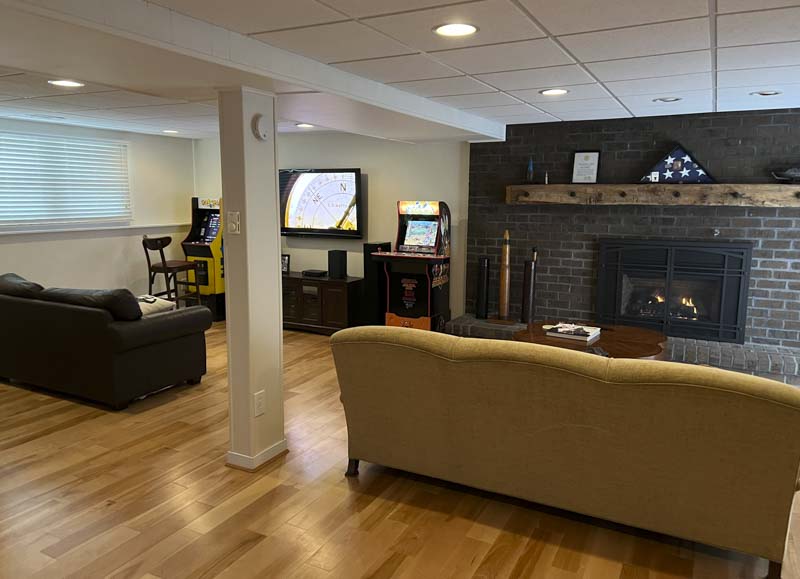
There’s a wide range of styles to choose from when it comes to laminate flooring, and choosing the right one for your home will ensure that it works with the style you have. Here are some factors to consider when you’re choosing laminate flooring:
- Thickness of planks–Typically available in 7mm to 12mm.
- Width of plank–Commonly found in widths from 3” strips to 7” wide planks.
- Color and shade–Available in many neutral colors and shades.
Local Climate
Factors like your local climate and water table can determine whether laminate flooring is a suitable choice for your application. Laminate flooring works well in cold, dry climates, but in humid environments, it can become damaged due to too much moisture absorption.
Maintenance Routine
Laminate flooring is easy to care for, but it helps to establish a maintenance routine to preserve its appearance. Regular cleaning by sweeping or vacuuming to remove dirt and debris will help protect the wear layer.
Occasionally, you can use a damp mop to clean your laminate floors. Excess moisture can lead to buckling, warping, and damage around the edges of the planks. You can also avoid damage by using entrance mats, protective pads on furniture, and handling spills promptly.
FAQs About the Pros and Cons of Laminate Flooring
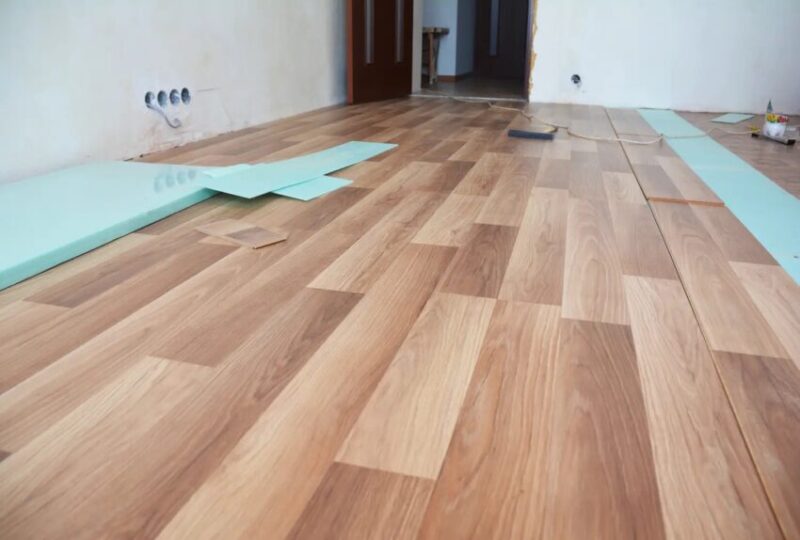
Is laminate flooring suitable for bathrooms and kitchens?
The best laminate flooring for kitchens and bathrooms is one that’s highly water resistant. There is a lot of moisture in these areas, which causes the interior layers of laminate flooring to swell, especially around the edges and seams. If you do install laminate flooring in your kitchen, be sure to clean up any spills immediately.
Can I install laminate flooring over existing flooring?
As long as your existing floor is level and smooth, you can install laminate flooring over it. Some types of flooring that laminate flooring cannot be installed over include natural stone, brick, and carpet.
Are there eco-friendly laminate flooring options available?
There are many eco-friendly laminate flooring options available. Here’s what to look for when you’re choosing laminate flooring that is aligned with your environmental goals:
- Certifications from organizations like the North American Laminate Flooring Association
- Testing for zero or low formaldehyde emissions
- Recycled content
- Low VOC finishes
You can also research the manufacturer and read laminate flooring reviews to understand more about their manufacturing process and determine if they use sustainable materials.
How long does laminate flooring last?
On average, laminate flooring lasts about 15 to 25 years. The lifespan of laminate flooring depends on several factors, including the product quality, how well it’s maintained, and how much wear and tear it gets over the years.
How do I repair scratches or damage to laminate flooring?
Repairing deep scratches or dents in laminate flooring is simple to do, especially if you have an artistic eye. Use a wood filler, and once it dries to a hard finish, sand it smooth. You can use a matching varnish or stain pen to color it to match the rest of your floor.

